As an Amazon Associate, I earn from qualifying purchases. There is no extra cost to you. Thank you if you use our links; we appreciate it! Learn More.
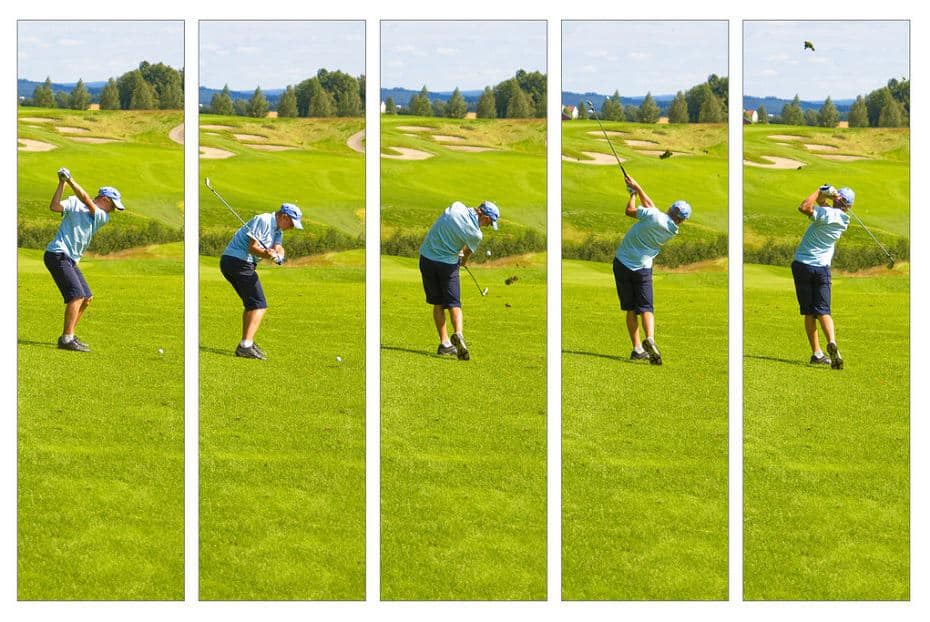
One of my first questions about golf was: ‘How to swing a golf club?!!?’ And look at me…Today I am answering it!!
Golf is a game of Patience and perfection. Did I say Perfection? It must require patience for a great performance, but perfection is a word for your diary. You cannot be perfect for your shot or any other tasks. So you should try to improve what you have and what you can achieve.
Swing a Golf Club is the most basic and number one technique to follow in a Golf Course. You certainly don’t want to be a part of a joke missing your first shot. When you take the shot, you might need to focus on your swing, direction, and distance.
In this article, I am going to introduce you with the pro like swing of a club starting from a beginner. It is very important to adjust your club with the best golf swing techniques shot.
So, let’s get to know- how to swing a golf club for beginners.
Why is Golf Swing Sequence Important?
The golf swing sequence is important because it determines the path and speed of the clubhead and ultimately affects the ball’s flight and distance. A well-executed swing sequence can help a golfer generate power, control, and accuracy in their shots.
Here are a few specific reasons why the golf swing sequence is important:
Power
The swing sequence plays a key role in generating power in the golf swing. By following a specific sequence, the golfer can maximize the transfer of energy from their body to the clubhead and ultimately hit the ball further.
Control
The swing sequence also helps the golfer control the clubhead’s path and speed, which is critical for hitting accurate shots. By maintaining a consistent swing sequence, the golfer can better control their shots and hit the ball straighter.
Consistency
Consistency is an important aspect of the golf swing, and the swing sequence plays a key role in achieving it. By following a consistent swing sequence, the golfer can more easily repeat their swing and hit better shots more consistently.
Overall, the golf swing sequence is a critical aspect of the golf swing and plays a key role in generating power, control, and accuracy in a golfer’s shots.
What are the 3 key physics concepts of the golf swing?
The three key physics concepts that are important in understanding the golf swing are:
Kinetic energy
Kinetic energy is the energy of motion. In the golf swing, the clubhead has kinetic energy as it moves through the swing. This kinetic energy is transferred to the ball upon impact, causing it to travel a certain distance.
Angular momentum
Angular momentum is a measure of an object’s rotational motion. In the golf swing, the golfer’s body and the club form a system that has angular momentum. By manipulating this angular momentum, the golfer can control the direction and distance of the shot.
Read: How do you golf with a baseball swing?
Center of mass
The center of mass is the point at which an object’s mass is evenly distributed. In the golf swing, the golfer’s center of mass plays a crucial role in maintaining balance and control. By keeping the center of mass in the correct position throughout the swing, the golfer can generate more power and accuracy.
Understanding these physics concepts can help a golfer analyze and improve their swing, as well as understand how different factors such as clubhead speed and ball spin affect the flight of the ball.
What are the 3 keys to the golf swing?
There are many different elements that can contribute to a successful golf swing, but some of the most important ones include the following:
Grip
How you hold the club can have a big impact on the direction and power of your swing. A good grip allows you to control the club and make consistent contact with the ball.
Stance
Your stance is the foundation of your swing, so it’s important to get it right. A good stance will help you maintain balance and generate power through the swing.
Alignment
Proper alignment is essential for hitting the ball straight and true. This means aligning your body and the clubface correctly with the target.
Other important factors in the golf swing include the takeaway, the backswing, the downswing, and the follow-through. By focusing on these key elements and practicing regularly, you can improve your golf swing and lower your scores on the course.
Turn, tilt, and bend
Turn, tilt, and bend are another three elements that can be involved in the golf swing, but they are not typically considered to be the “keys” to the golf swing. Instead, the keys to the golf swing are generally considered to be grip, stance, and alignment, as I mentioned before.
The turn refers to the rotation of the body around the spine during the swing. The tilt refers to the angle of the spine in relation to the ground. And the bend refers to the amount of flexion or extension in the legs and spine during the swing.
While these elements can certainly affect the golf swing and are important to consider, they are not necessarily the most fundamental or crucial aspects of the swing. Instead, grip, stance, and alignment are often considered to be the foundation upon which the other elements of the swing are built.
What are the 3 forces in golf swing?
In a golf swing, there are three main forces at play:
Gravity
Gravity is the force that pulls the club downward and towards the center of the earth. This force must be countered in order for the golfer to generate power and height in their shot.
Centrifugal force
Centrifugal force is the force that pushes the club away from the center of rotation during the swing. This force is generated by the golfer’s body as it rotates around the axis of the club.
Friction
Friction is the force that acts between the clubhead and the ball at impact, causing the ball to spin and determining its flight path. The amount of friction depends on the clubface angle and the roughness of the clubface.
Understanding and controlling these forces is critical for a successful golf swing.
Categories of the Mechanics of Golf Swing
Let’s talk about the categories of golf swing sequence. Whoever you are or what experience you have that doesn’t matter here. I am going to help you – beginner to pro- in this article. But this would be categorized for you to help yourself in specific areas.
If you are a beginner you may be amazed at the Golf course. But if you are planning to take a club then you need some rules to follow. Without the proper technique, you will feel like a bird without wings. So do not fly without wings that can damage your limbs.
I have seen a lot of tutorials online about how to swing a club. But everywhere it is yet to complete the full guidance. So I have decided to describe it thoroughly with no step skipped.
There should be three categories to answer how to swing a Golf club.
Read: Steps to increase the swing speed in Golf
Beginners Target – Take the ball out in the air
When I saw the Golf first on a television, I felt like what are they doing with this stick and ball? Some people with formal look trying to send the ball out of the park hitting by a stick. Yes, this is the basic target before you catch the club for the first time. You just need to know how the club should be used to hit the ball up in the air.
Intermediate – The patience to get going controlling the direction
When you are successful to send the ball in the air the next challenge goes on. Now it’s the time to focus on controlling the direction of the ball. As a beginner, you already know you have a target where the ball should be sent. It is important to control the direction of the ball to score in first place. Keep your patience and practice more to make it more precise.
A pro like focus – Controlling the distance and consistency in every shot
Hey, congratulation, you have the basic and now you are up ahead of practice the long shot. Now the most important part of this pro session is to focus on the distance. Maintain the aim and try to hit in a specific distance to achieve the target.
For once or twice, you may hit the ball in the almost perfect distance. But it is not possible to make it consistent without more practice. As a human being, it is impossible to maintain the same posture and target for every shot. So it should be close in every single hit.
Steps of How to Swing a Golf Club Correctly for Beginners
Now you can decide on which phase you want to start from. I think most of you will be amid the beginner and intermediate. But it doesn’t matter as you have to start from the beginning to practice the swing. I have described the target of the swing of your club. Now it is time to elaborate the guide on how to golf swing.
I have made some steps to make the training guide easy for everyone. The steps are–
Read also: Callaway Strata Review : For beginner to experienced
1# The posture or ultimate stance
Why is the Golf posture so important? Statistics show that most of the beginners do not bother about the stance or posture. They just try to hit hard and fail to achieve the distance in no time. You have to understand that it is not about the beat the ball by a stick.
You have to think about the stance, the swing and the technique to pass the distance. So do not hesitate to use your brain in the first place and learn how to swing a club more effectively. Let’s dig through the detail about the mastering of stance.
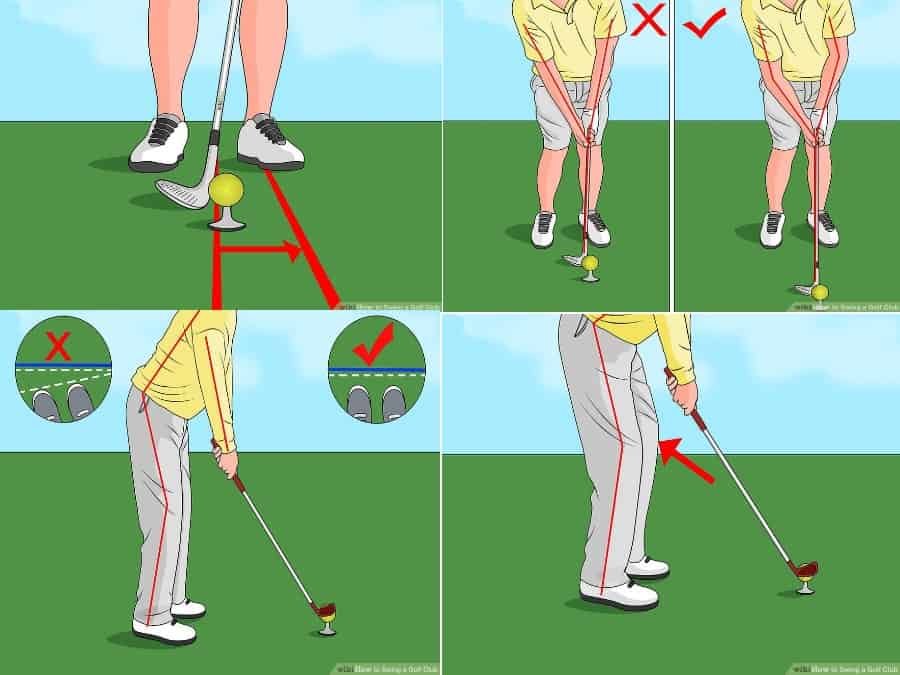
The front foot position
Foot position is the first important part for your shot. You have to place your foot in the correct position to have a good hit. The front foot should slightly be ahead of the ball so that the club rest in the middle of the body.
The feet position should be wider compared to your shoulder. This way, your Golf ball will take the mid position of your feet placement. If you use a bigger club like hybrids or drivers you should play it towards your front foot and towards the middle of the posture in case of your smaller club or irons.
For a right-handed player, it should be the opposite. The left foot on your stance should be one foot or fewer closes than the hole and the ball. But if you are left handed your right foot will take the same position. After that, the standing position makes the difference.
You need to stand close enough so that the clubface reaches the ball straight using your arms. Make sure your arms and body are relaxed. If it is not, you should concentrate to make it again.
If you stand away from the ball, your hand will be outstretched and tired. You just need to bend away from your torso and the upper body needs to be slightly bent towards the ball.
Read: Cleveland Launcher Hb Irons Review
Alignment and The Knee
Another important lesson for the perfect shot is the feet alignment. The feet should be aligned with your shoulders at the same point. The back foot to front foot should be on your target directly. This is the square alignment. If you are not sure about your alignment, let’s check the stance. Place your club and check back the direction it’s pointing in. if it is pointed at your target or at the hole you are in the perfect alignment.
The knee should be slightly bent for an athletic stance. The straight knee position is so tough to make an athletic shot. You can check it with a shadow practice and you will feel it so uncomfortable to hit the ball. Balancing your weight is also influence the mechanism of your shot.
Read: Best golf Halloween costumes
The football balance will be difficult than the balance on your heels. But it makes easier to shift your body weight forward and then backward to play your shot. Before the final cut distribute the weight in both feet evenly. In any kind of shot, it would be an advantage to distribute the body weight evenly.
The proper alignment of you knee is important to avoid knee injuries too!
2#The different grips and details
After the stance, the next step is to fix the grip. A relaxed and comfortable grip will allow you to perform an accurate swing and better distance. It is not about trying harder but the impact with the club. Even if you use the utmost energy you might not achieve the distance you want. It may cause your muscle tense and increase the chance of injury. So try to be relaxed and comfortable.
Read: Amazon Prime Day Deals
Different Grips
You can try differently available grips to play the shot perfectly.
I am now giving you the details about the grips. First of all, I recommend trying the baseball grip. It is the pretty similar grip of a baseball batter. Let’s discuss the baseball grip in detail –
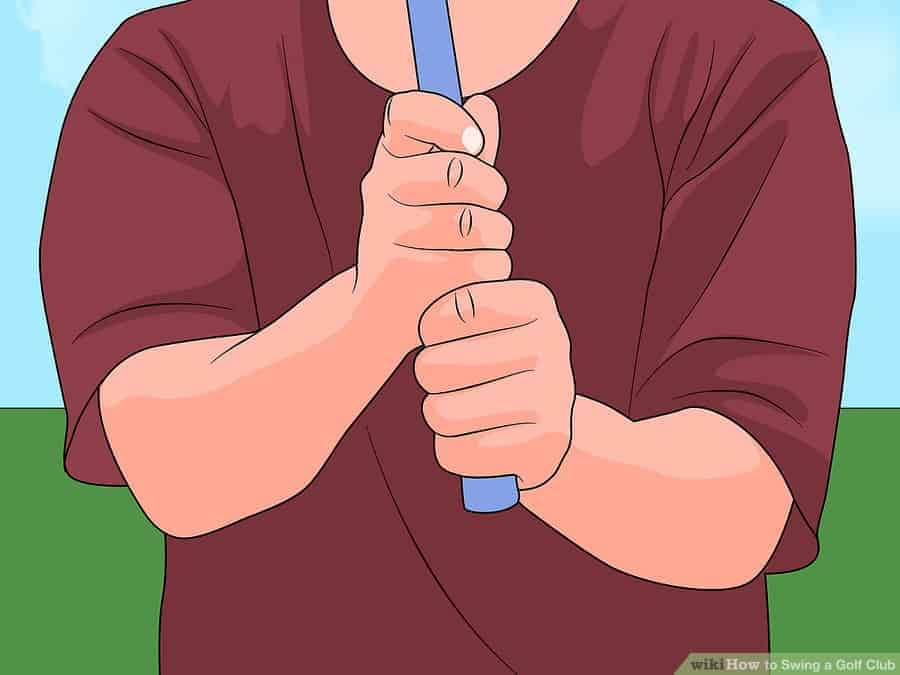
It will be the same for left-handed and opposite to a right-handed person. Place your left hand underneath the club and your hand will get a secure grip. Your club should be at the palm of the hand. Place the right hand underneath the club as your pinky finger can touch the index finger of left hand.
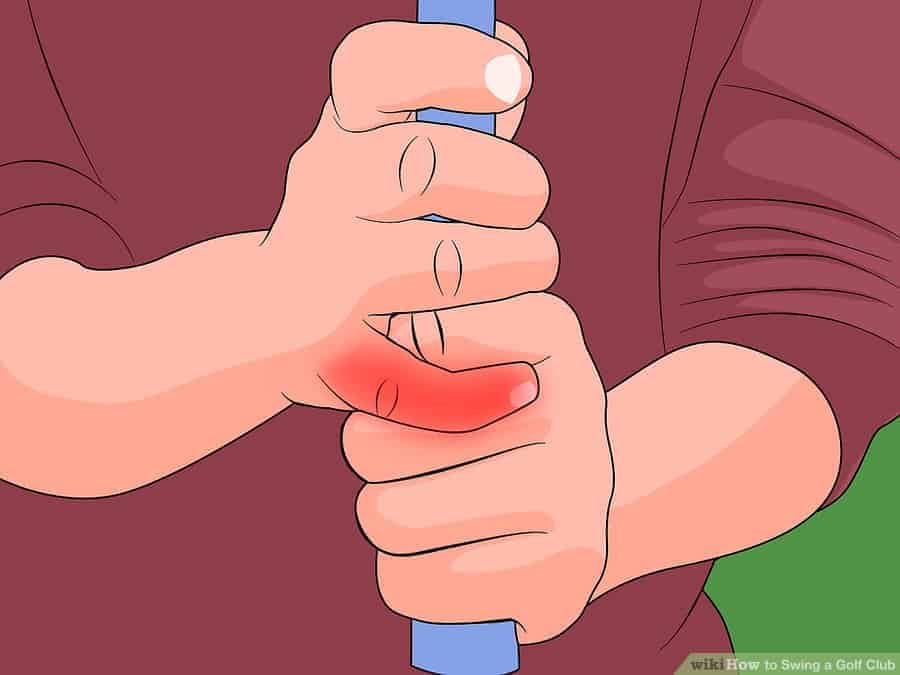
Another grip for your shot is overlap grip. In this grip, you will get your fingers connected. So this grip provides more stability than the baseball grip. In this grip, your pinky finger of your right hand will overlap the left index finger. With this grip, you will get more of your perfection than the basic baseball grip.
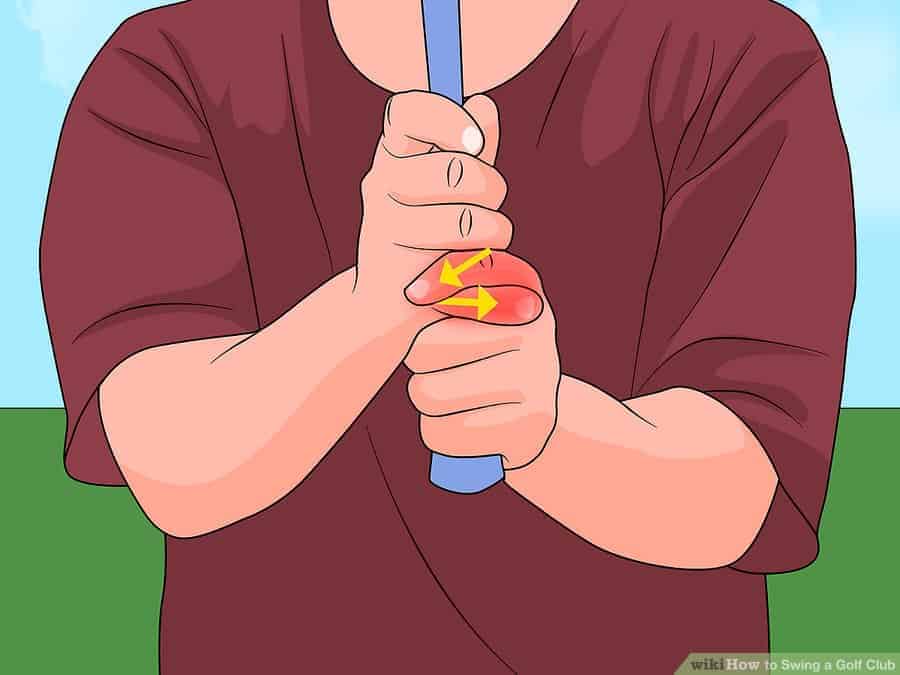
The grip we will cover now is the interlocking grip. In overlap grip, you will find the pinky finger from your left hand overlap the index finger of your right. But in interlocking grip, these two fingers make the joint like the x shape. This one is considered the most stable grip in Golf.
The great players like Tiger Woods use this grip. To make the interlocking grip first follow the baseball grip. After that, place your left index finger between the right pinky finger and ring finger.
Choosing the perfect Grip
You have read about the grips of Golf. Now it is time to decide which one is comfortable for you. You should select the most comfortable for one for you. You will find a lot more variations too. But we have some recommendation.
If you have problems with the slice you should consider the strong version of the grip. But in terms of the hook, you should do the opposite. The strong version will work in this aspect. The interlocking grip is recommended for players with small hands. But the overlapping one is not much comfortable for smaller hands.
3#The final phase – Swing of the club
This is the final step of how to swing a club. I have described in some steps. At first, it comes with the backswing.
The Backswing
Start the backswing shifting your body weight from the front foot to back foot towards the ball. The club will start the backswing from the above your head. Move your hands behind the back to keep it close to your back leg.
After that it will come down with a slight wrist break and the club would be roughly 90 degrees to your left arm for right-handers (the right one for left-handers). At the final phase, the torso needs to rotate back further behind the hands and the weight needs to transfer back to front foot.

The downswing
Follow through with your downswing it should be dragged or pulled a little to lag behind anything else. Then the 90-degree forearm allows the tremendous clubhead speed through the impact area. The most important part of the downswing is to lock your front arm to ensure the proper impact.
Read: Starting the downswing in golf
You also need to shift the body weight from the back foot to front foot. Keep your knees little flexed and move forward to the target which will help the front leg to keep the weight.

The impact and Follow through
Now the moment comes for what you are trying for. You need to ensure the shaft leaning forward toward the target before the impact. Remember to follow through which will ensure to complete the swing of your club. At every step like backswing, downswing or follow through, keep your eyes on the ball.
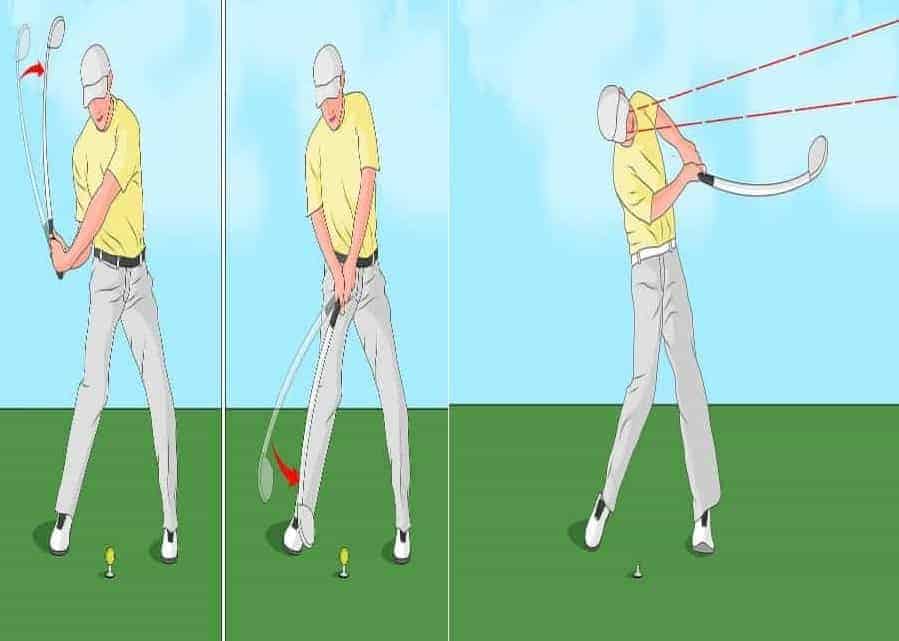
4#Common mistakes to take care of
There are some very common mistakes you need to take care of. Such as:
The Ideal Golf Swing Sequence
The ideal golf swing sequence involves a number of different movements that work together to produce a powerful and accurate shot. Here is a general outline of the sequence:
Address the ball
This involves positioning your body and the club in a way that allows you to hit the ball effectively. Stand with your feet shoulder-width apart, bend your knees slightly, and align your body parallel to the target line.
Take a grip
There are many different grip styles in golf, but the most common is the overlapping grip, where the little finger on the trailing hand (the hand on the bottom of the grip) overlaps the index finger on the lead hand (the hand on top of the grip).
Waggle
This is a small back and forth movement of the club that helps you feel comfortable and relaxed before making a swing.
Take the club back
Begin the backswing by turning your shoulders away from the target and taking the club back along the plane of your shoulders. Keep your arms relaxed and let the clubhead follow the natural arc of your swing.
Top of the backswing
At the top of the backswing, the club should be parallel to the ground and the shaft should be pointing at the target. The majority of your weight should be on your back foot and your head should be behind the ball.
Start the downswing
Initiate the downswing by turning your hips and shifting your weight onto your front foot. As you do this, allow the club to “fall” from the top of the swing and start moving towards the ball.
Impact
As the clubhead reaches the ball, the hands should be ahead of the clubhead and the clubface should be square to the target. The body should be fully rotated towards the target, with the weight on the front foot and the hips fully turned.
Follow-through
After impact, continue to swing the club through the ball and towards the target, keeping your arms extended and your head behind the ball.
By following this sequence and making smooth, controlled swings, you can produce powerful, accurate shots that land on the fairway or green.
Common Mistakes
There are many common mistakes that golfers make during the swing. Some of the most common mistakes include:
- Swaying or sliding during the swing: This can cause the golfer to lose balance and control over the club.
- Casting or releasing the club too early: This can cause the golfer to hit the ball too high and with too much spin, resulting in a loss of distance and accuracy.
- Lifting the head during the swing: This can cause the golfer to lose sight of the ball and miss the shot.
- Improper grip: A grip that is too strong or too weak can cause the golfer to hit the ball off-center and lose control.
- Improper posture: A poor stance can cause the golfer to have poor balance and a lack of control over the club.
- Improper alignment: Misaligned feet or shoulders can cause the golfer to hit the ball off-line.
- Poor tempo: A swing that is too fast or too slow can cause the golfer to lose control and accuracy.
To avoid these common mistakes, it is important for golfers to work on their swing mechanics, practice consistently, and seek the guidance of a golf pro if necessary.
Frequently Asked Questions (FAQs)
What’s the best way to swing a golf club?
The best way to swing a golf club is by relaxing your body and swinging the club freely. Just keep a good grip of the club and bend your body a little bit, then swing the club freely. Too much force and keeping the body straight never makes a good swing.
How important is a follow-through in a golf swing?
Follow through in a golf swing is very important as it influences the power you generate to make a stroke. Moreover, it plays an important role in driving the golf ball to the target with good.
How important is a full shoulder turn in the golf swing?
Shoulder turn in the golf swing is important for a couple of reasons. It helps to maximize the amount of torque, helps to gain good distance and gives a proper angle to hit the golf ball towards your target.
The Final Thought
Now you have completed the swing of a golf club. The swing of a golf club might be an incident of a few seconds. But the answer of how to swing a golf club was that big. The process of swing is not so easy to learn. You need to maintain focus and control throughout the whole process.
Don’t act like a mannequin while taking the swing. You need a perfect shot. So follow the steps and make your knee flexed, move your feet and remember the weight shifting to make your swing comfortable.
Amazon and the Amazon logo are trademarks of Amazon.com, Inc, or its affiliates.
Daisy is the Founder and Editor in Chief of Golfs Hub. She is associated with Golf for more than 20 years. She got the inspiration from her father. She is a very private person & doesn't like to be photographed. She's worked in nearly every job in the golf industry from club fitting to instruction to writing and speaking. Now she is enjoying her retirement from day job... but not from Golf! Daisy lives in southeasternmost part of New York state with her family.






Flexibility may be the single most important factor in making a successful golfer. A compact, powerful swing is defined by the x-factor—or the relationship of shoulder to hip rotation. “The shoulders should turn at a 90-degree angle over the hips, which should turn 45 degrees—that’s the x-factor.